Instructions
Wisdom teeth grow outermost in the gum, i.e. behind the second molars (typical “sevens”) and are called third molars or “eights.” Such a distant location determines their secondary role in grinding food. The main set of teeth necessary for chewing food is 28 teeth, so “eights” are considered “excessive luxury” and are called wisdom teeth.
Wisdom teeth are formed when the last milk teeth are replaced by molars, i.e. at about 13-15 years old. However, they take quite a long time to form and begin to erupt only after 20 years. This long time their complete formation is due physiological characteristics body, because when teething baby teeth, children scratch their gums, bite toys and thereby increase blood flow and metabolic processes that help faster teeth to form. And the third molars are so far away that when chewing, food falls on the first and second molars, and the gums above the “eights” are poorly supplied with blood and are not “massaged” during chewing, which prolongs the process of tooth formation.
Wisdom teeth usually grow in stages. You may experience gum discomfort and sometimes pain for 1-2 weeks, and then all signs of tooth growth subside for several weeks or even months. The growth of “eights” is influenced by hormonal surges in the body; for example, it has been noted that during pregnancy the growth of wisdom teeth is greatly activated. Can trigger growth last teeth pronounced inflammatory processes in the body, which are accompanied by a prolonged increase in temperature.
According to the observations of dentists, the third molars in some people take decades to grow, so if at the age of 20-22 you showed signs of growing “eights”, this does not mean that you will soon have 30-32 teeth. Wisdom teeth often have a paired pattern of growth, i.e. If the upper third molar on the right has come out, then soon expect the same tooth on the left.
The long eruption of wisdom teeth is also due to the fact that they often have an incorrect location, i.e. can be laid at an angle and, when growing, rest against the “seven”. Of course, it is almost impossible for a tooth located parallel to the gum to erupt, so it gradually turns over. This time may take several years, i.e. - if a tooth begins to erupt at the age of 21, the full formation of its location will end by about 30 years.
The process of teething is complicated by inflammation of the gums above the wisdom tooth. If it has at least erupted small part tooth, a focus of infection is formed, into which food fibers and microbes enter, and this place is difficult to access for cleaning. When the gums become inflamed, they become loose and often “pockets” form in them - additional easily infected areas. The surgeon cuts off the “pockets” above the erupting wisdom tooth, thereby facilitating the eruption of the tooth.
If by the age of 27-30 you have never had any signs of the formation and eruption of third molars, then the chances of these teeth appearing after 30 years are negligible, because All formation processes in the body subside by this age, and teeth are no exception.
There are 32 teeth in both jaws of an adult. Teeth wisdom- the last in each row, they erupt later than the others. Thanks to this feature, they got their name, although they have nothing to do with intelligence or wisdom. In dental parlance, these are called third molars.
According to the structure of the teeth wisdom They are no different from the others: they have a root, neck and crown covered with enamel. But they have several peculiar features. Firstly, they do not have milk precursors; secondly, they do not always erupt. Normally, they should grow in a person between the ages of 17 and 30, but in reality this may happen much later or not happen at all. Many thousands of years ago, teeth wisdom occupied a worthy place in the dentition of the human jaw, which was then slightly larger, since the ancestors of people ate tougher foods and had a massive jaw. There were no problems with these teeth. But gradually humanity switched to soft food that did not need to be chewed so thoroughly. In addition, the brain enlarged, which affected the structure and maxillofacial apparatus. The third molars began to cease to participate in the act of chewing and became rudimentary, continuing to grow in the jaw, in which there was much less space for them. So with teething wisdom many people have problems. Since they grow late, in conditions of lack of space, and overcoming a mechanical obstacle, they cause pain. In addition, their growth is often accompanied by various complications, for example, the third molar may take correct position in the jaw and lie horizontally or at an angle. As the lower teeth grow, they sometimes touch nerves or destroy their neighbors; they grow towards the cheek or tongue, causing inflammation and pain. IN Lately cases of missing tooth buds are becoming more frequent wisdom, which confirms the opinion about the vestigial nature of the third molars. Although in other people these teeth grow without problems and are fully functional. Scientists still cannot say
The process of appearance of almost all teeth occurs in childhood, except for the third molars. Therefore, many people wonder, when does a wisdom tooth grow in this case? The fact is that the physiological eruption of eights occurs according to special rules - they begin to climb much later than the others, when the human body is almost mature. It is for this reason that the third molars are designated “wise.”
At what age should we expect teething and what should we prepare for? Despite the similarity in anatomical structure with other molars, wisdom teeth are rightfully considered the most unique and unpredictable.
They have several key features, may not grow at all or come out partially, while their attempts to break through the gums and take their place in the dentition for a person almost always take place against the background of discomfort.
In the process of evolutionary development, the third molars have lost their primary functional purpose and today are considered vestigial organs. They participate little in the act of chewing, but can become a support for bridge prostheses in the future, provided they are proper development, which is extremely rare in practice.
At the very end of the top and lower jaw Two rudiments of the third molars are symmetrically laid down, and there are four in total. The growth of third molars occurs from rudiments, the development of which is planned for the period of complete replacement of permanent molars, that is, at the age of 13-15 years. Wisdom teeth are cut only after the formation of the crown part, and this moment occurs at adolescence, while root growth continues for another three years.
When eights appear, a person can expect many surprises.
Concerning anatomical structure, then visually they are no different from other multi-rooted teeth. But if you pay attention specifically to the roots, then eights can have up to 5 of them, they mostly grow crookedly, with complex bends, and are prone to merging, which creates the illusion of one thick root. Of course, this feature is not a plus in all respects. First of all, such root canals cannot be properly cured.
In addition, eights differ in other ways pathological abnormalities. Very often, the developmental timing of the rudiments is disrupted; they may have an irregular shape and size, and occupy the wrong position inside bone tissue and are located with abnormal deviations.

Some directions in which they can cut through.
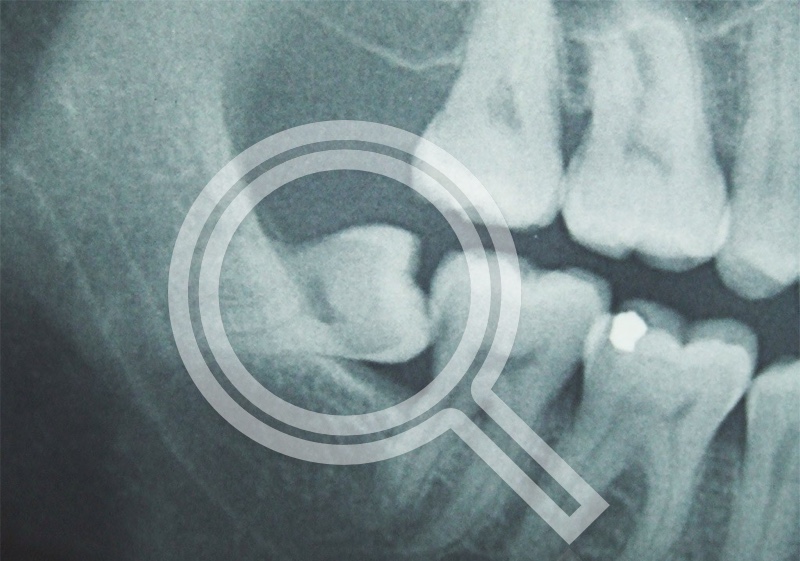
In practice, dentists rarely encounter patients with physiologically correct vertical growth; much more often they encounter such phenomena - the figure eight lies horizontally, resting its roots on the seventh tooth, is located at a strong inclination, putting pressure on the cheek or adjacent molars, due to the atypical angle of inclination it does not may come out or partially make its way through the gum.
All these non-standard qualities of wisdom teeth significantly complicate and delay timely eruption, negatively affect the condition of the dentition, and also explain the painful state of a person at the germination stage. Moreover, discomfort also occurs in people with the correct direction of growth. After all, third molars climb through unprepared periodontal tissues, since baby teeth did not grow there before. A normally erupted molar is a cause for joy.
When do wisdom teeth appear?
When is a wisdom tooth cut? This moment occurs individually for all people. But there are certain time frames during which eights erupt. As a rule, the timing of wisdom teeth eruption varies from 16-17 to 25 years.
Sometimes it happens that the figure eight finally comes to the surface much later than the established deadlines, by the age of 30 or even 35, and for some it may not appear at all, remaining impacted inside the gum.
If you are wondering until how many years wisdom teeth grow, then the answer is simple - throughout life until old age. There are cases when they began to erupt in old age.
As for how long a wisdom tooth grows, you can understand that eruption does not happen in one day - this process is prolonged and can take several months, while the unpleasant symptoms temporarily subside, and then again make themselves felt with a new wave of pain.
How to recognize the germination of eights
When a wisdom tooth emerges, it overcomes bone tissue, so its growth is always accompanied by a set of characteristic signs:
- appears pain syndrome varying degrees expressiveness;
- with severe inflammation, the temperature may rise to 38˚C;
- the gums around the cutting tooth swell, become swollen, and sometimes the mucous membrane and tongue also hurt;
- the cheek swells near the place where it erupts;
- regional lymph nodes become denser.

The longer the process of figure eight growth occurs, the more periodontal tissue will become inflamed. Against this background, the situation is very often aggravated by the occurrence of complications. As a rule, due to severe pain, a person tries not to touch the erupting tooth once again, and therefore does not fully brush his teeth. Because of this, food debris gets under the swollen gums, bacterial plaque accumulates in large quantities, and all this is a source of infection.
How long will this painful process last? Almost everything depends on the individual person and his clinical picture. You can do it differently. Do not wait for final germination, but simply contact your dentist to clarify the situation. The doctor will take an x-ray, thanks to which it is possible to formulate an adequate prognosis, as well as take the necessary measures. If their abnormal structure is discovered, then most likely the doctor will advise you about the need to remove such problematic molars.
Problems during their growth
When a particular person’s wisdom tooth is cut is also influenced by hereditary factor. That is, if the parents have not encountered a similar phenomenon, then with a high degree of probability the child will not grow third molars either.

Problems accompanying wisdom teeth during growth.
When a new wisdom tooth grows in, sometimes the crown only manages to break through the alveolar process a little, and the remaining area is covered by the mucous membrane. As a result, a gingival overhanging hood is formed, under which food debris and bacteria accumulate, which leads to inflammatory process. Many people encounter this phenomenon, and it is called pericoronitis. The patient experiences throbbing pain, difficulty opening the mouth and the act of chewing, a bad odor comes from the mouth, and pus may appear near the hood.
In case of pericoronitis, it is necessary to contact a dentist, otherwise the tooth will appear for a long time and persistently. The doctor will remove the obstacle to the growth of the figure eight by excision of the overhanging gum. But if it is determined that there is insufficient space on the jaw, then it is advisable to remove the tooth so that it provokes crowding of the remaining teeth.
It is advisable to stop the growth of dystopic molars (improperly positioned) immediately, rather than wait until a certain age, since such teeth are a clear indication for removal. By the way, it is better to remove eights in your youth, before their root system has had time to fully form. But in mature years, the extraction procedure and the recovery period are much more difficult.
So, above, you learned when wisdom teeth begin to grow, at what age problems appear, and what you should start doing if eights appear. If you have any questions, watch this video.
Most teeth erupt in humans childhood. But there is an exception to this rule - wisdom teeth. They appear later than everyone else. It is believed that this is why they were given such a name.
So what is the difference between “wise” teeth and all the others? At what age do they appear? How long do they grow? And can they not cut through at all?
What you need to know about wisdom teeth.
How many should there be?
The normal number of wisdom teeth or “eights” in a person is 4. These are the outer molars on the lower and upper jaw, erupting much later than all other teeth.
 But it is impossible to speak unequivocally about their number, since over time the human jawbone underwent evolution and decreased in size. The consequence of this was a reduction in the number of teeth located on it.
But it is impossible to speak unequivocally about their number, since over time the human jawbone underwent evolution and decreased in size. The consequence of this was a reduction in the number of teeth located on it.
Therefore, some people grow all 4 “eights”, some have two, and some of these chewing elements may not appear at all.
Most often, wisdom teeth erupt in pairs. But there are cases when a person develops only one or three last molars in a row.
Features of location and eruption
- These are the outermost teeth on both sides of the lower and upper jaw. Like other paired teeth, they are located symmetrically relative to each other and are the eighth in a row, starting from the middle incisor. Hence their dental name – “eights”.
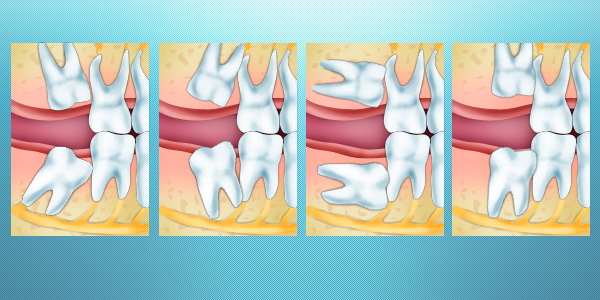 Unfortunately, the peculiarity of these teeth is that they rarely occupy the correct position on the jaw bone. Often these molars develop and erupt with some abnormalities. This can be expressed in their incorrect location or direction of growth, which brings a lot of trouble to a person.
Unfortunately, the peculiarity of these teeth is that they rarely occupy the correct position on the jaw bone. Often these molars develop and erupt with some abnormalities. This can be expressed in their incorrect location or direction of growth, which brings a lot of trouble to a person.
Very often, a wisdom tooth grows at an incorrect angle in relation to the rest of the teeth and to the jaw, and can rest against the cheek or the roots of its “neighbor”. But even if the extreme molars grow correctly, their eruption is almost always accompanied by some discomfort and pain.
Since there were no milk teeth in this place previously, the “eights” have to independently make their way to the surface of the gum. In this case, a person may begin to feel pain in this place long before teething. Often the appearance of a wisdom tooth is accompanied by inflammation and swelling of the eruption area.
Features of the anatomical structure
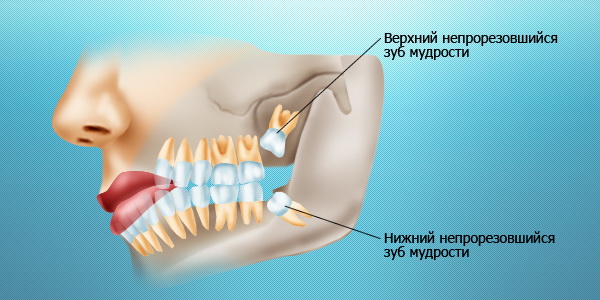 Externally, wisdom teeth look exactly the same as other multi-rooted teeth. But the G8s have a number of differences in their structure. In particular, this applies to their part hidden in the gums. Usually these teeth have four, less often five, roots.
Externally, wisdom teeth look exactly the same as other multi-rooted teeth. But the G8s have a number of differences in their structure. In particular, this applies to their part hidden in the gums. Usually these teeth have four, less often five, roots.
Sometimes it happens that the outer molars have only one or two roots. But this is only an appearance; in fact, these are several roots fused into one. Often, the root canals of wisdom teeth are curved, which makes them very difficult to treat or remove.
The eruption of eighth molars is shrouded in many myths and prejudices. In this regard, patients have many questions related to their growth, which we will try to answer.
At what age do wisdom teeth begin to grow?
The rudiments of wisdom teeth begin to develop after the child has suffered and all 28 permanent teeth have grown. Usually this period from 13 to 15 years.
But they begin to appear after 17-18 years, in some cases this happens only by the age of 30. Until this time, they grow inside the jaw. The formation of roots occurs even later, when the “figure eight” has already appeared on the surface of the gum.
When do the last molars grow?
Most often, the eighth teeth begin to erupt in period from 18 to 25 years.
But over time, these terms become more and more arbitrary. Nowadays, it is not at all uncommon to appear at the age of 30-35, and sometimes only in old age.
How long does it take for a tooth to come out?
It is impossible to name the exact growth time for wisdom teeth. For each person it is purely individual. “Eights” can erupt over several months or ten years, all the while causing pain and other inconveniences.
The growth of the extreme molars from time to time is replaced by periods of activity and rest, they either freeze, then again begin to move towards the surface of the gum. This process can take many years.
Maybe they don't exist?
All people have the beginnings of figure eights. But this does not mean at all that they will break through to the surface of the gums and there will be a full set of 32 permanent teeth on the dentition.
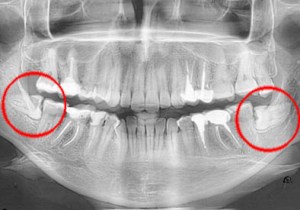 Jaw structure modern man makes it increasingly difficult for wisdom teeth to erupt. Sometimes they simply do not have enough space on the jawbone, and they remain in the embryonic stage.
Jaw structure modern man makes it increasingly difficult for wisdom teeth to erupt. Sometimes they simply do not have enough space on the jawbone, and they remain in the embryonic stage.
But there is also such a phenomenon as. This is a full-fledged molar, but it is completely or partially hidden in the jaw bone or gum.
Such teeth, despite the fact that they never erupted, usually have completely normal sizes. In addition, they can get sick just like everyone else.
The growth of wisdom teeth is very individual. Both the time of eruption of the “eights” and their location on the human jaw differ.
In any case, taking into account the peculiarities of the structure and development of wisdom teeth, you need to treat them with special care. And if necessary, contact your dentist immediately.
Most changes in our body go unnoticed. Who can now remember how many centimeters he grew in the 15th year of his life and how long his wisdom tooth grows? Like, important points, but the memory of this is quickly erased, the person begins to perceive the “new” self as the only true and possible option.
What can cause toothache?
We remember about teeth only when they begin to bother us:
- Unbearable pain prevents you from falling asleep at night, causing fatigue and impotent anger;
- Every meal turns into torture;
- You have to constantly chew on only one side;
- You gradually give up solid food;
- Any thoughts about the dentist are accompanied by no less horror than memories of iced tea after a hot dinner.
No one is immune from dental problems. Of course, constant care and regular visits Seeing a dentist increases the chances of a healthy smile, but even this is not 100% protection of teeth from any damage.
Pain always indicates pathological process. As a rule, it is a companion to inflammation:
- Due to improper gum care;
- Due to the destruction of a previously damaged tooth;
- Due to problems with teething;
- Due to food remaining between the teeth.

Do wisdom teeth heal?
Not every wisdom tooth needs to be removed immediately if there is some problem.
Dentists usually try to save the “eight”:
- If the tooth has already erupted;
- When there are chances for a “prosperous future”;
- With an unexpressed inflammatory process.
A molar tooth can be filled in the same way, a pin can be inserted into it, and any other dental procedure can be performed. If the doctor thinks it’s easier to drill and grind off part of the enamel, that’s exactly what he’ll do. After all surgical removal- a procedure with many possible complications. They try to resort to it in extreme cases, but a lot depends on the attending physician.
Ask your dentist:
- Is it possible to keep the tooth?
- What volume of treatment is needed;
- How to care for your oral cavity after manipulation;
- In how many sessions can improvement be achieved?
You shouldn’t trust the phrases: “Why do you need this tooth, it’s not involved in chewing anyway, let’s remove it.” Complications will come to you, if anything happens, and not to the dentist. So think about your well-being first.

A wisdom tooth is coming out - what to do?
The period of wisdom teeth eruption itself can last from several weeks to a couple of months. Patients do not have enough patience for more and they go to the doctor themselves when the pain and constant discomfort outweigh the fear of the dental office.
If you find that the “eight” is growing somehow wrong:
- Make an appointment with your dentist;
- Rinse your mouth with anti-inflammatory agents;
- Do not rely on narcotic painkillers;
- Use non-steroidal anti-inflammatory drugs;
- Don't delay your visit to the doctor.
It will not be possible to “straighten” a tooth at home, since it has already begun to grow incorrectly. Even if you pick up pliers, you won't be able to do anything. Painkillers and anti-inflammatory drugs will only help get rid of unpleasant symptoms in the form of pain, swelling and redness.
The dentist must:
- Examine the oral cavity;
- Send for x-ray;
- Based on the conclusion, decide on further tactics;
- Notify you of your options;
- Remove or treat a tooth.
Theoretically, all this can fit into one session, without stretching it over several days. The main thing is to gather your courage and force yourself. After all, even if it turns out to be an hour discomfort, but after that the pain will go away.
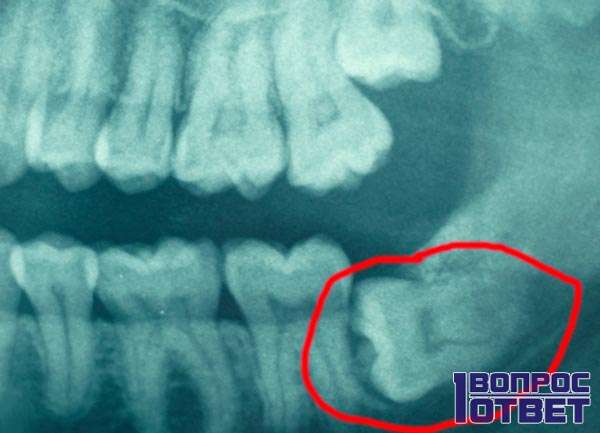
Are wisdom teeth necessary?
In fact, a person has many rudimentary “processes” and wisdom teeth are one of them:
- They erupt after puberty, before which a person chews food without any problems;
- Do not participate in the act of chopping food;
- They remain a “hello” from our ancestors with a large facial section of the skull;
- Absolutely unnecessary with modern jaw sizes;
- Missing in some people.
Some may have moved on to the next stage of evolution, but most still acquire 4 additional teeth closer to 20 years of age. The gift is not a pleasant one, considering possible complications upon appearance and after removal, but there is no escape from it.
Anatomists distinguish two sections of the human skull - facial and brain. To make it clear - skull, in which the brain fits. And the face - mouth, nose, eyes, brow ridges. In modern man brain section prevails over the facial one - in terms of size.
Our ancestors had it the other way around:
- More pronounced forehead;
- Huge brow ridges;
- Jaws protruding forward;
- A large circle that could accommodate 32 teeth.
Evolution, taking its course, changed the proportions of the head. But she left the number of teeth unchanged. And although now each jaw has become a couple of centimeters shorter - just 2 teeth above and below, the number “32” continues to haunt humanity to this day. With rare exceptions.
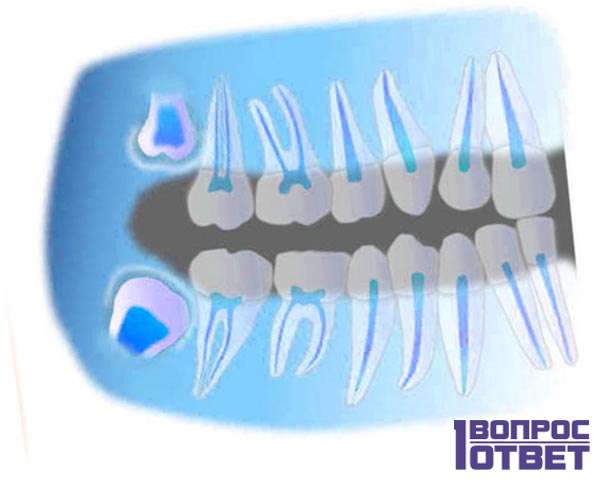
Problems with "eights"
Wisdom teeth are 4 rudimentary “processes” inherited from our distant ancestors:
- Do not take part in mechanical grinding of food;
- They erupt within a couple of weeks, if without complications;
- Due to lack of space, their appearance may be accompanied by pain and inflammation;
- The first “candidates for removal” for many dentists.
Despite all their uselessness, not all dentists prefer to remove figure eights. And all because of the risk of developing complications, and there is already a full set. Starting with mild swelling and ending with severe intoxication.
If your molars have started to come in:
- Make sure with a mirror that they grow in that direction;
- At painful sensations- rinse your mouth with anti-inflammatory agents;
- If you can’t stand it, use painkillers; the same NSAIDs can help;
- As soon as you suspect that the process will be delayed, make an appointment with your doctor.
You should not put off until tomorrow what can be cured today. Well, or this week.
The pain makes you wonder how long a wisdom tooth should grow and how much longer you can endure it? Unfortunately, if there is not enough space, the process can drag on for an unlimited period of time.

Video about teeth growth
In this program, guest dentist Anatoly Lopatin will tell you at what age wisdom teeth grow, what they are needed for and how to properly care for them:
Want to know everything! Wisdom teeth.
At what age do wisdom teeth appear?
Why are they called that?
By the age of 18, a person usually has all permanent teeth. Only the so-called wisdom teeth grow later - at 18 - 25 years. One person may have all four wisdom teeth, while another may have two or one. And some people do not have them at all, and this is not considered a deviation from the norm. The appearance of wisdom teeth is not always painless. Sometimes they erupt with difficulty and put pressure on neighboring teeth and injure surrounding teeth. soft fabrics, causing inflammation. It is difficult for a person to open his mouth, chew, or speak, and the temperature may rise. In such cases, you should consult a doctor. Often those whose wisdom teeth erupt painfully wonder if they can be removed. This should not be done without medical indications. It is better to preserve any tooth, including wisdom teeth. In addition, if the need for prosthetics arises in old age, they can be very useful.
Wisdom teeth
An adult has 32 teeth. The incisors and canines are located in the front of the mouth. On the sides of the canines are small molars (premolars) and large molars (molars). Each side of the jaw has three molars. The last third molars are the wisdom teeth. Wisdom teeth appear on average between 16 and 25 years of age. Although, they may not erupt and may remain in their infancy all their lives. There are four wisdom teeth in the oral cavity, one on the right and one on the left on each jaw.
What does embedded wisdom tooth mean?
In dentistry, an immersed tooth is a tooth that has not fully erupted and has not taken its place in the dentition. An erupted tooth is a tooth that has protruded above the gum level and reached the antagonist tooth of the opposite jaw. The reason for incomplete eruption (immersion) is that there is not enough space in the dentition for this tooth, or the wisdom tooth has an incorrect inclination. Immersed wisdom teeth in dentistry are divided according to the direction of immersion. According to the direction of immersion, wisdom teeth are divided into 4 types: medial, distal, horizontal and vertical.
The most common type of impacted wisdom teeth are medially impacted teeth. The term "medial" means that the wisdom tooth is angled forward toward the front teeth. The term "distal" means that the wisdom tooth is tilted posteriorly.
Wisdom teeth with vertical, horizontal, and distal immersion are rare.
Wisdom teeth are also divided into teeth with tissue and bone immersion. If the tooth remains in the thickness of the jaw and does not appear on the surface, then they speak of “bone immersion.” If it has passed through the bone, but has not completely cut through the gum, then this is called “tissue immersion.”
What problems can sunken wisdom teeth cause?
The following problems may occur due to wisdom teeth:
- Pericoronitis
- Wisdom tooth caries
- Dystopia
- Damage to the roots of adjacent teeth
Pericoronitis
Pericoronitis is an inflammation of the gums around a partially erupted tooth. This is the most common complication associated with the eruption of wisdom teeth. The tooth erupts gradually. First, one of its cusps appears, forming a gap in the gum, and the rest of the tooth remains covered by it, forming a hood. The hood around a partially erupted tooth is a potential site for infection.
Due to the difficulty of cleaning, food residues accumulate in this place, foreign bodies and ideal conditions appear for the proliferation of bacteria, which cause inflammation of the soft tissues around the wisdom tooth.
Wisdom tooth caries
We already know that caries occurs on those surfaces of the teeth where plaque accumulates. Wisdom teeth are the outermost teeth and are often difficult to reach with a toothbrush. Constant “under-cleaning” of plaque leads to its accumulation and the formation of caries. In addition, if a tooth has partially erupted, then it is located under the overhanging edge of the gum (hood), which also contributes to the accumulation of a large amount of plaque and prevents tooth brushing. Often the position of the wisdom tooth is such that it is difficult to clean out the plaque between it and the adjacent tooth. In this case, caries can affect the contact surface of not only the wisdom tooth, but also the adjacent one.
Dystopia
Dystopia is the incorrect position of a tooth in the dentition, manifested by its displacement towards the cheek, tongue or rotation around its axis. There is an opinion that when a submerged wisdom tooth erupts, when there is not enough space in the dentition, it puts pressure on other teeth, as a result of which they shift and occupy an incorrect position in the jaw.
Damage to the roots of adjacent teeth
As we have already mentioned, the wisdom tooth often takes on an incorrect position in the jaw, even to the point of being horizontal in the bone. At the same time, it can, as it were, “rely” on the root adjacent tooth, and when cutting through, apply significant pressure on it. As a result, the root of the adjacent tooth begins to dissolve.
When should wisdom teeth be removed?
There are no clear age criteria for wisdom teeth removal. It is better to remove embedded wisdom teeth in at a young age, because The sooner they disappear, the lower the risk of complications associated with them. This is, firstly. Secondly, what younger body, the easier various surgical procedures are tolerated and the faster healing occurs after removal. Thirdly, it is less traumatic to remove teeth whose roots are not yet fully formed and the surrounding bone tissue is less dense.
Wisdom tooth removal
The first step in wisdom tooth removal is pain relief. After anesthesia, the dentist begins to remove the embedded wisdom tooth. Because An embedded wisdom tooth may be located under the gum and covered with bone tissue; the dentist provides access to remove the wisdom tooth. To create access, the dentist cuts into the gum and then removes the area of bone overlying the tooth.
In order to remove as little bone as possible, the dentist will often separate the wisdom tooth into pieces when removing it. Dental burs are used for this. After dividing the wisdom tooth, the dentist uses special instruments to remove each of these parts of the tooth.
After removing a wisdom tooth, the dentist places stitches in the area extracted tooth, because he cut the gum and provided access to remove the wisdom tooth.
Some types of threads used to make these sutures subsequently dissolve by themselves, and the dentist himself removes the non-dissolving sutures. Non-dissolving sutures are usually used - the process of removing them is very simple and painless.








